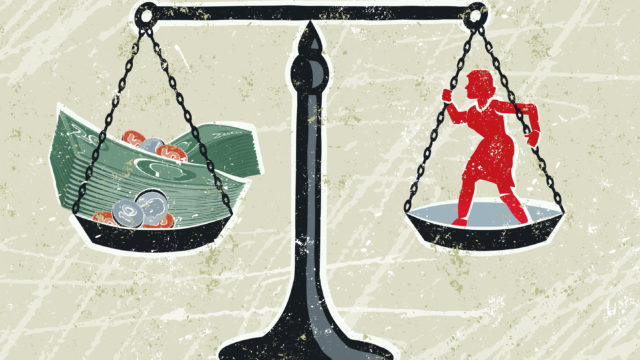This post was written by Donna Seymour, advocate and member of the St. Lawerence County Branch of AAUW-NYS as part of our PowHer the Vote 2017 campaign.
For all the positive things we see happening in New York State for women economically, and there has been a lot of progress, we are still a long way from where we need to be.
On the plus side, for example, on Halloween this year, a new law takes effect in New York City prohibiting employers from inquiring about a candidate’s salary history during the hiring process. The law is designed to delink lifelong pay inequalities for women by uncoupling them from their salary histories. From October 31 on, any such inquires are unlawful and discriminatory.
PowHerNY and our many allies worked hard during the 2017 legislative session to get a similar salary history bill passed in New York State legislature. Hopefully we’ve laid the ground work for passage in 2018.
On January 1, New York will institute most one of the most progressive paid family leave policies in the nation. Phased in over several years, the new law will apply to newborns, adopted or foster children, as well as ill family members, including children, in-laws and domestic partners. Those families with a member called to active military service also qualify. And since the payment of benefits comes out of payroll deductions, employers do not bear the burden to cover costs.
But – and there is always a but – New York City sits atop a list of 10 worst megacities for women in terms of economic opportunity, according to a new survey ranking the world’s metropolises for their sexism. The Thomson Reuters Foundation looked at 19 of the world’s biggest megacities and ranked them based on how safe they are for women, as well as the level of access to healthcare, education and economic opportunities.
Thomson Reuters Foundation spoke to experts on women’s issues in each of the cities and rated the cities based on their scores in four categories:
- Sexual violence (“Women can live in this city without facing the risk of sexual violence including rape or sexual attacks or harassment.”)
- Access to healthcare (“Women have good access to healthcare including control over reproductive health and maternal mortality.”)
- Cultural practices (“Women are well protected from potentially harmful cultural practices including female genital mutilation, child, early or forced marriage, female infanticide.”)
- Economic opportunities (“Women have access to economic resources such as education, ownership of land or other forms of property, and financial services such as bank accounts.“)
This past weekend the Women’s Convention was held in Detroit, a convening of nearly 4,000 people, mostly women, as a follow up to the wildly successful Women’s March held in Washington, DC and many other locations following the Trump Inauguration in January. The issues under discussion in Detroit included the same ones women rallied over last January:
Republican efforts to repeal the Affordable Care Act, threats to the environment, mass incarceration, reproductive rights, workplace rules, the accessibility of child care, treatment of immigrants, protections for transgender people, and sexual harassment and assault.
The answer to the question, Why these issues are still unmet?, even in relatively progressive places like New York City and New York State, is simple: It is the lack of women at the table in the state legislature and the halls of Congress.
Women make up just over half the population and are the majority of voters, yet women – especially young women with the most to gain or lose – are not exercising their full electoral power, either at the polls as voters or as candidates.
Election Day 2017 is just around the corner, yet we know these off, off year elections attract the fewest voters, on average. However, it is through local elections that voters have the greatest power to effect change. We’ve seen over and over again that when progress is stalled in Washington and the state capital, it is through leadership at the municipal level that real change can begin. Paid Family Leave was a New York City innovation before it passed in Albany.
Across the country, the majority of Americans are dissatisfied with the political state of the nation:
Seven in 10 Americans say the nation’s political divisions are at least as big as during the Vietnam War, according to a new poll, which also finds nearly 6 in 10 saying Donald Trump’s presidency is making the U.S. political system more dysfunctional.
But dissatisfaction extends well beyond the executive branch: Even more Americans, 8 in 10, say Congress is dysfunctional, and there is limited trust in other institutions, including the media.
While the poll finds similar levels of distrust in the federal government as before Trump took office, it also finds that pride in U.S. democracy is eroding. The share of Americans who are not proud of the way the country’s democracy is working has doubled since three years ago — from 18 percent to 36 percent in the new survey conducted among a nationwide sample of more than 1,600 adults by The Post and U-Md.’s Center for American Politics and Citizenship.
Majorities of both Democrats and Republicans say America’s politics have reached a dangerous low point, though more Democrats (81 percent) than Republicans (56 percent) hold that view.
This has been deliberately cultivated by cynical politicians and organizations who want to foster helplessness, fear and apathy in our citizens. Because apathetic, depressed citizens won’t do the one thing that can change the direction of the country: Run for office and vote for candidates who offer a new vision for the country.
There is a power vacuum in this country. Robert Reich, who served in the administrations of Presidents Gerald Ford and Jimmy Carter and was Secretary of Labor under President Bill Clinton from 1993-97, has pointed out that the old Democratic and Republican parties are exploding.
“When you take a closer look, America actually has 6 political parties right now. Whoever can put together elements of a governing coalition among these groups will win future elections.” Watch his video essay on this question.
But in order to take advantage of these dynamic shifts in political power, we have to be willing to step up to claim the opportunity. The good news: there is evidence this is starting to happen.
More than 15,000 women across the country have contacted Emily’s List in 2017 to express interest in running for office—a new record for the organization. They’ve watched as senators Kamala Harris and Elizabeth Warren are interrupted and silenced by their male colleagues, and lamented that at an all-male cohort of senators retreated behind closed doors to draft a Senate health-care bill that would have imperiled millions of women’s health, from maternity care to access to birth control.
According to a She Should Run spokesperson, in a normal month the organization sees “at best, and with significant effort, anywhere between a few dozen to a few hundred women” sign up. But in the three months since the election, co-founder and CEO Erin Loos Cutraro said 8,100 women have indicated their interest in running foroffice by registering for She Should Run’s online incubator program, which teaches them how.
Female donors are skyrocketing and more women are considering runs. The number of female donors to federal candidates and committees has skyrocketed by roughly 284 percent so far in the 2017-18 election cycle compared with this time in the 2015-16 cycle, according to research from the nonpartisan Center for Responsive Politics. The number of women donating to a federal campaign has increased by a staggering 670 percent when compared with the early months of the 2011-12 cycle.
Having a critical mass of women decision-makers, rather than a token presence, will allow new ideas and new voices to be heard with new perspectives and solutions to old problems. This idea is taking hold. In Detroit at the Women’s Convention:
In small rooms, speakers led detailed training sessions for candidates at all levels: how to get the vote out, how to give a campaign speech, how to register voters, how to run for office.
“The goal here is for people to go back to their local communities and prepare for 2018 and to build power, register voters, engage more people, organize on a very hyper level,” said Linda Sarsour, one of the organizers of the Women’s March and of this convention, which leaders here view as the first of its kind since women met inHouston in 1977. “We’re excited to see what happens in 2018.”
Women – and society – have nothing to lose and everything to gain. Remember:

This post originally appears on Donna Seymour’s blog and can be viewed here.


